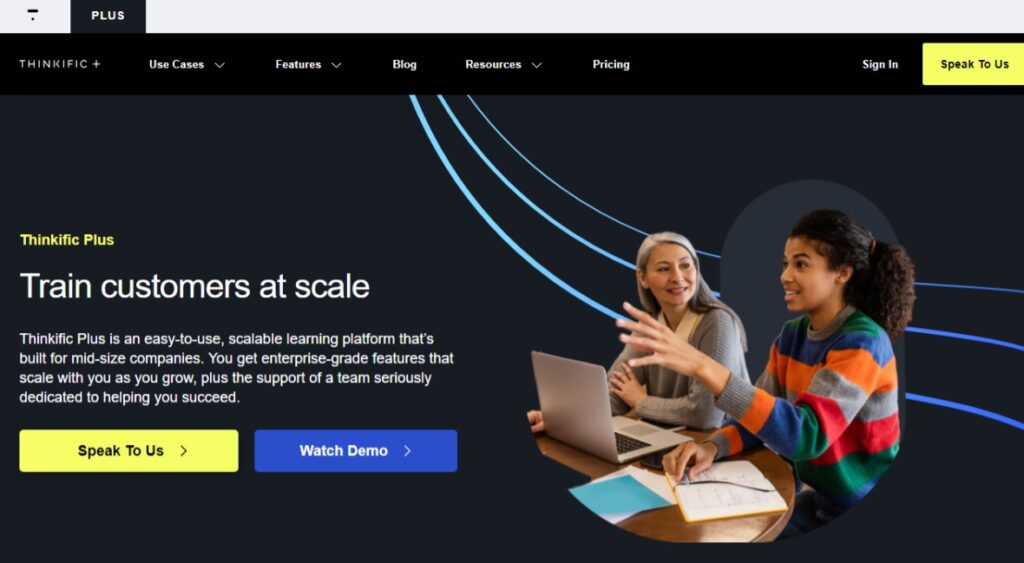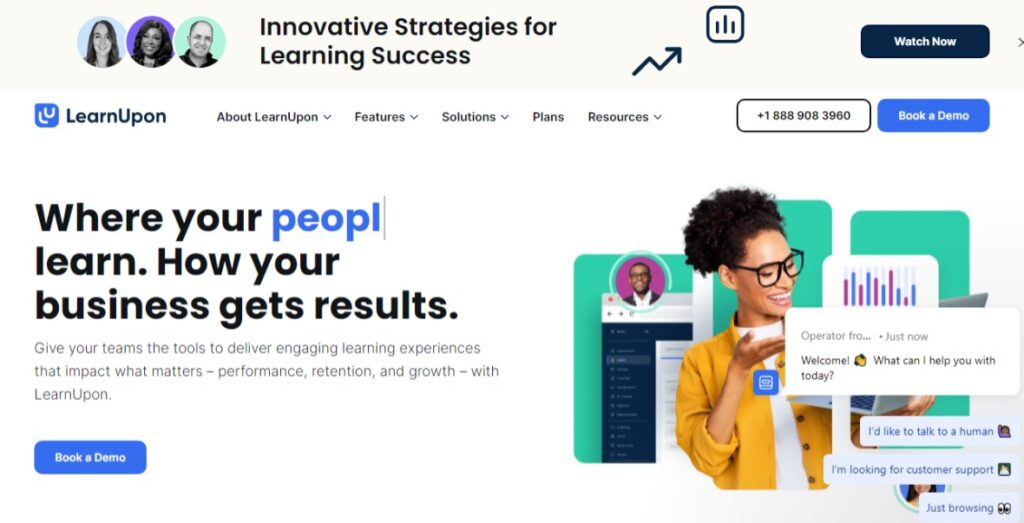In the world of customer education, employee training, and learning management systems (LMS), Skilljar is a robust platform serving businesses of all sizes. Its name is synonymous with comprehensive learning management, offering features like:
- Course creation
- Progress tracking
- Varied integration
- Efficacy analytics
But that doesn’t mean it’s right for everyone. There are many reasons why an individual or organization might seek alternatives to Skilljar.
Perhaps they require a more cost-effective solution, different features, better customization, and ease of use, or they might be looking for a platform better aligned with their specific industry needs.
We’ve created a comprehensive guide if you’re wondering what other options could meet your unique learning management needs. We’ll explore some popular Skilljar alternatives and the features that make them stand out and analyze the pricing, feedback, and unique selling points of each.
Skip ahead:
-
Key Features to Look for in Skilljar Alternatives
Comparing Top Skilljar Alternatives
Case Studies: Success Stories with Skilljar Alternatives
Key Features to Look for in Skilljar Alternatives
When researching Skilljar vs other platforms, it’s important to consider your organization’s unique needs. Here are some essential features to look for to help ensure the platform you choose can effectively support your specific learning management requirements.
Customization and Flexibility
Personalized learning experiences are paramount. An LMS should offer extensive options to customize courses, allowing them to be tailored with your organization’s branding and unique content.
Pay attention to features like editable learning paths and customizable certificates that align with your training goals. They should also support various content formats to accommodate various learning preferences, from videos and interactive modules to quizzes and text-based documents.
Your LMS should be able to scale up effortlessly as your user base grows and your training needs become more sophisticated. The ideal platform would stay current with the latest trends, like mobile learning, social learning, and gamification, ensuring it remains relevant and effective.
User Interface and Experience
A Skilljar competitor’s user interface is a direct reflection of its potential for success. It should boast an intuitive layout that learners and instructors can understand swiftly, eliminating any unnecessary complexity hindering the learning process.
All users, regardless of their technological proficiency or disabilities, should be able to access the platform and understand how to operate within it.
Integration Capabilities
Given the interconnected nature of business tools today, the ability to integrate smoothly with other systems—such as CRM, HRIS, or marketing automation software—can drastically improve efficiency and data coherence.
An LMS that offers API access and has pre-built integrations with commonly used business systems will ensure you can connect to the larger ecosystem of your organizational tools.
Comparing Top Skilljar Alternatives
When evaluating Skilljar alternatives, it’s important to consider the array of options that align with your specific learning management needs. Each alternative brings its unique blend of features, pricing models, and user experiences to the table.
| Platform | Key Features | Best For | Price Range |
| Thinkific Plus | Customizable course creation Branded mobile app creation
Integrated e-commerce |
Growing businessesMobile learning
Engagement-driven education |
Contact for quote |
| LearnUpon | Unified learning platformFlexible learning paths
Robust reporting |
Corporate trainingExtended enterprise
Compliance management |
Scales based on user count |
| Docebo | AI-driven learning pathsSocial learning capabilities
Extensive integrations |
Learning at scaleInnovative approaches
Tech-forward enterprises |
Three-tiered structure based on user count |
Related:
Thinkific Plus

Thinkific Plus is a powerful, scalable online course platform designed for businesses looking to deliver high-quality training experiences. The platform offers a seamless way to create, market, and sell online courses.
It’s built for individual educators and large organizations seeking to deliver professional training or educational courses at scale. Thinkific Plus is known for its robust, easy-to-use course builder, a comprehensive set of sales and marketing tools, and exceptional customer support.
Key Features:
- Customizable course creation: Offers extensive branding and design options to match company aesthetics and learner engagement preferences.
- Branded Mobile: Create a white-label app for your online courses and communities.
- Integrated e-commerce tools: Provides built-in payment processing and multiple sales options, including memberships and course bundles.
Best for:
- Growing businesses: Ideal for entrepreneurs and SMBs expanding their online learning offerings.
- Mobile learning: Learners can connect with their course material through a variety of platforms and devices.
- Engagement-driven education: Great for businesses that prioritize keeping learners engaged and motivated through interactive courses.
Price Range:
Thinkific Plus takes a tiered approach to pricing, offering different plans to fit various business sizes and needs. The plans start with basic functionality and ramp up to more advanced features, including white labeling, advanced integrations, and full analytics.
Contact Thinkific for bespoke pricing, but rest assured, there’s a plan structured to provide value whether you’re just starting out or scaling up your operations.
Related: Learn how Thinkific Plus helps streamline customer education, increase activation, and reduce churn.
Conclusion:
Thinkific Plus is a compelling Skilljar alternative emphasizing user-friendly course creation, robust sales opportunities, and a high degree of customizability. It’s especially suitable for those seeking a platform that combines strong e-commerce capabilities with effective learning management.
LearnUpon

LearnUpon is a versatile learning management system alternative designed to help businesses develop, deliver, and track staff training. It is also widely used for customer and partner training, distinguishing itself with its commitment to creating a memorable learning experience for all users.
Its feature-rich platform is engineered for companies of all sizes, aiming to align training with their business goals.
Key Features:
- Unified learning platform: Centralizes the training process for employees, customers, and partners in one accessible platform.
- Flexible learning paths: Provides tools to create structured learning paths for different user groups, enabling personalized learning experiences.
- Robust reporting: Offers in-depth tracking and reporting capabilities for administrators to monitor learner progress and training impact.
Best for:
- Corporate training: Perfect for businesses eager to develop and track employee training programs rigorously.
- Extended enterprise: Designed for organizations that train external stakeholders, such as customers and partners.
- Compliance management: A strong fit for companies that require meticulous record-keeping for compliance training purposes.
Price Range:
LearnUpon’s pricing model is based on the number of active users and the level of features required by the business. There are three levels—Essential, Premium, and Enterprise—for 150, 150-500, and 500+ users, respectively.
For a detailed quote tailored to specific organizational requirements, LearnUpon advises contacting their sales team.
Conclusion:
LearnUpon is a solid Skilljar alternative for organizations demanding a comprehensive, all-in-one LMS that aligns training efforts with business objectives.
Its strength in providing combined training solutions across different segments, paired with robust reporting functions, makes LearnUpon a top contender for businesses serious about the measurable impact of their learning initiatives.
Go deeper: Compare Thinkific vs LearnUpon
Docebo

Docebo is an AI-powered learning platform that delivers a personalized and automated learning experience at scale. It engages the learner while providing administrators powerful tools to manage, deliver, and track training more effectively.
Aimed at mid-to-large-sized companies, Docebo is highly regarded for its sleek user interface and robust feature set, including gamification, social learning, and integration capabilities.
Key Features:
- AI-driven learning paths: Uses artificial intelligence to recommend content and create adaptive user learning experiences.
- Social learning capabilities: Encourages knowledge sharing and collaboration among learners with features that mimic social network functionalities.
- Extensive integrations: Seamlessly integrates with a wide range of enterprise software, enhancing the platform’s utility within diverse business ecosystems.
Best for:
- Learning at scale: Best suited for larger organizations needing scalable solutions to train numerous employees or clients worldwide.
- Innovative learning approaches: Ideal for companies looking to leverage AI and social learning to enhance their training programs.
- Tech-forward enterprises: Designed for businesses seeking a sophisticated, future-oriented LMS that easily integrates with other enterprise tools.
Price Range:
Designed with enterprise needs in mind, they have a flexible pricing structure catering to various business sizes and training complexities. Prospective customers should reach out to Docebo directly for a custom quote.
Conclusion:
Docebo is an attractive option for businesses investing in cutting-edge, AI-driven learning management system alternatives. With its advanced personalization and social learning features, Docebo is particularly well-suited for organizations looking to create dynamic, interactive, and automated learning experiences at scale.
Go deeper: Docebo Alternatives
Case Studies: Success Stories with Skilljar Alternatives
Sometimes, real-world examples are the best way to determine whether an LMS is effective. Here are two satisfied clients who chose a Skilljar alternative and quickly found success.
Case Study 1: Schudio
In 2019, Schudio, a company specializing in website design for educational institutions, recognized the importance of empowering its clients through education. They launched SchudioTV, an innovative online learning platform built with Thinkific’s robust course creation tools.
Initially, SchudioTV focused on customer education and product training, helping clients maximize the impact of their storytelling capabilities through Schudio’s design services.
But they quickly saw an opportunity to do something even more important.
SchudioTV began to provide indispensable, on-demand training for parents and educators working with students with Autism and other special educational needs and disabilities (SEND).
The courses, crafted with care and professional insight, quickly became a beacon of support and learning for those who play critical roles in the lives of SEND students.
Today, with over 60 meticulously designed courses and a staggering 50,000 enrollments, SchudioTV has marked its presence on the global stage. Schudio’s exceptional platform now equips educators worldwide with the skills and knowledge to make a real, tangible difference in the SEND community.
Case Study 2: Jason Yee
Jason Yee’s journey from a former professional hockey player to an international online mentor began by creating a humble YouTube channel focused on hockey.
Leveraging Thinkific’s powerful course delivery, Jason transformed his practical insights and expertise into two comprehensive online courses. The goal was simple yet audacious: empower hockey players to “10x their potential on the ice.”
With a learner-centric approach, the platform offers flexibility, allowing athletes to train and learn at their own pace, regardless of location.
Jason’s dedication and the effectiveness of his training modules resonated with the hockey community, leading to a rapidly growing enrollment of over 2,100 students globally.
Future of Learning Management Systems
The LMS landscape is evolving rapidly, shaped by technological advancements, changing workforce dynamics, and a continuous quest for improved learning methodologies.
By 2030, the global market for higher education LMS platforms is expected to reach $58 billion, with a compound annual growth rate of over 16.4%.
Here are some emerging trends to watch out for as the market matures:
Artificial Intelligence (AI) and Personalization
AI is increasingly being integrated into LMS platforms to provide personalized learning experiences. AI algorithms can recommend courses, adjust learning paths based on performance, and offer adaptive learning opportunities that cater to individual needs.
Related: We created some Free AI tools for Course Creators
Mobile Learning
With remote work and mobile devices becoming ubiquitous, LMS providers are optimizing their platforms for mobile learning. This trend allows learners to easily access educational materials anytime and anywhere, facilitating continuous learning outside traditional settings.
Microlearning
This approach involves short, focused learning sessions designed to match the learner’s attention span and make it easier to absorb knowledge. LMS platforms are embracing microlearning by providing bite-sized content that can be consumed on-demand.
Gamification
Introducing game design elements into the learning experience helps to engage and motivate learners. Leaderboards, points, badges, and interactive scenarios are becoming common features in LMS platforms to enhance user engagement.
Social Learning
Social features like discussion forums, peer feedback, and collaborative tools are being embedded into LMSs. These enable learners to interact, share knowledge, and solve problems together, fostering a community-driven learning experience.
Thank you for exploring these LMS options with us.
Making the right choice is crucial for your online learning success. If you’re ready to take the next step and get personalized guidance, pricing details, and a live demo, don’t hesitate to reach out to our experts.
Request a call with a member of our Thinkific Plus solutions team today, and let us help you unlock the full potential of your online learning journey.
FAQ
What are the main reasons to consider Skilljar alternatives?
The primary reasons to consider alternatives to Skilljar include seeking better pricing options, desiring different features or customization capabilities, or looking for a platform specializing in a specific industry or type of training.
How do Skilljar alternatives compare in terms of pricing and features?
Skilljar alternatives vary in terms of pricing—some offer tiered pricing based on features, while others charge based on user count or provide custom pricing models.
Feature-wise, alternatives may differ with unique offerings such as AI-driven personalization, advanced gamification, specialized integrations, or a focus on mobile learning.
What should organizations consider when switching from Skilljar to another platform?
When switching from Skilljar, organizations should consider the costs and logistics of data migration, potential downtime during the transition, user retraining on the new platform, and compatibility with existing software ecosystems.
What are the emerging trends in the learning management system market?
Key trends in the LMS market include the integration of AI for personalized learning experiences, shifting towards mobile and microlearning, and incorporating social learning and gamification to increase engagement.






